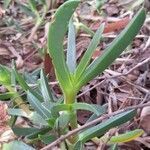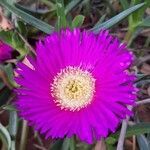A plant which forms a carpet over the ground. It spreads 2-4 m wide. The stems are slender. The leaves are succulent or soft and fleshy. They are triangle shaped in cross section. The leaves are up to 6-10 cm long and 5-8 mm broad. They are curved inwards and taper from the base. The flowering branches curve upwards. The flowers are large and purple or pink. They are 3.5-5.5 cm across. The flower stalks are 3 cm long. The fruit are 2 cm long by 1.5 cm wide and almost round. They are purplish-red.


